I ate at North America’s number 1 restaurant and can’t stop thinking about it

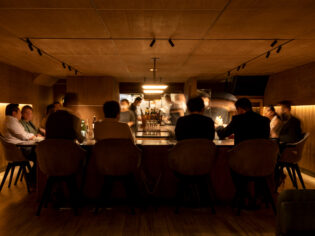
A purple grape, hot sauce and a Korean fine-dining icon taught me what separates a good meal from the greatest of my life.
It felt inevitable when New York City’s Atomix was crowned the number-one restaurant in North America by The World’s 50 Best Restaurants this year. Chef Junghyun ‘JP’ Park has quietly become one of the sharpest voices in modern Korean cooking: thoughtful, meticulous, and obsessed with balance. Atomix is his defining work.
After honing his craft at Melbourne’s Cutler & Co. and London’s The Ledbury, Park led the kitchen at New York’s Jungsik before launching Atoboy, a casual Korean restaurant co-founded with his wife and fellow food scientist, Ellia.
Atomix followed in 2018, then Naro at Rockefeller Center and the new Seoul Salon, establishing a multi-tiered Korean dining empire that now dominates New York’s hyperkinetic food scene.

Atomix establishes Korean cuisine as the finest in New York. (Image: Studio Writers)
I’ve eaten across all of Park’s venues (except Seoul Salon) and can confidently call Atomix the most memorable dining experience I’ve had. The reason lies in the couple’s unwavering dedication to Korea’s culture of precision and symbolism.
The Parks commission South Korean ceramicists for Atomix’s tableware, each piece echoing traditional forms. Guests choose their own chopsticks from a personal collection, and dishes arrive with handmade cutlery from long-established Seoul shops. The horseshoe-shaped counter, framed by minimalist geometry, mirrors the simplicity of Korean cuisine. Each course arrives with a collectable card, blending storytelling and augmented reality to visualise the inspiration behind the dish.
Conceptual, multisensory fine dining is nothing new, but rarely is it this studious. Yet atmosphere is only secondary to what truly distinguishes this as a top-shelf experience: a desire to keep finding the perfect flavours.
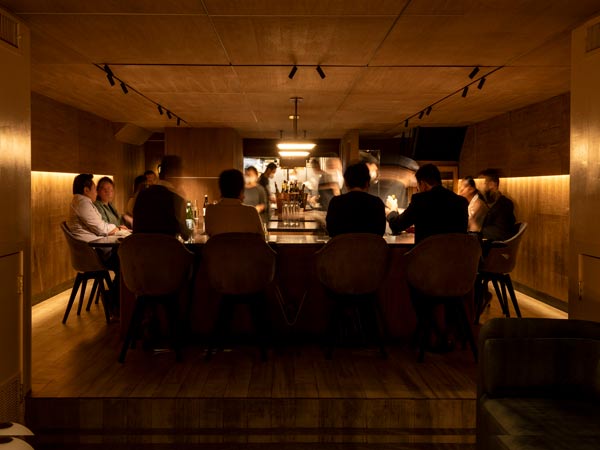
The dining room is equal parts intimate and inviting. (Image: Evan Sung)
Two floors above the dining room, an R&D kitchen and cocktail bar drive constant experimentation, dissecting fermentation and balance to push Korean cuisine beyond its familiar foundations of bap (rice) and banchan (small dishes).
The subterranean chef’s table is the endpoint for many of these dishes, worked into a 10-12 course set priced around A$610. That’s the most I’ve ever dropped on a dining experience. I didn’t expect to get my money’s worth, and yet the revelatory rollout of textures, temperatures and precision felt like a masterclass in how flavour behaves. It was like culinary Tetris, every piece fitting flawlessly.
Horse mackerel and monkfish liver overlapped on a crispy nuruk cookie. Creamy sea urchin served on steamed carrot cake. Pops of juicy Kristal caviar flecked between a medley of bluefin tuna, sugar snap peas and fermented cabbage. Buttery soft A5 wagyu lifted by tomato ssamjang with potato and chopi. I’ve never had a set menu as consistent and fascinating.
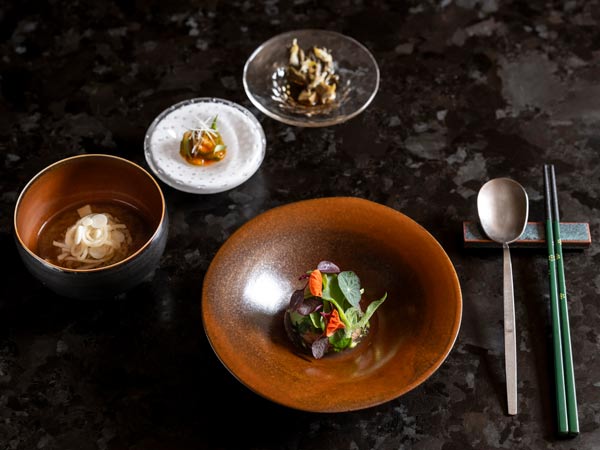
Each plate is a feast to the senses. (Image: Evan Sung)
Although it’s the fifth course, scallop with Japanese firefly squid, gochugaru and moo, that floored me. The squid’s squishy texture and dense flavour contrasts with the fresh flakiness of the scallop, swimming in a rich broth made from fish sauce and crème fraîche.
A slightly smoky gochugaru sauce brings it all together, rolling a pleasant heat across the palate for the most complex spice I’ve ever experienced. It’s smartly restrained, heightening the full-flavoured palate without overwhelming the premium ingredients.
I didn’t fully grasp Park’s intelligence until months later, sitting in a classroom at the Culinary Institute of America in New York State for its Taste Like a Chef masterclass.
A masterclass in taste
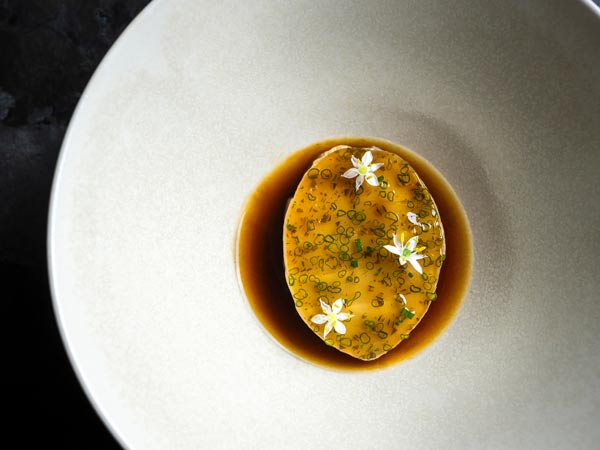
Exposure to different flavours refines one’s taste buds. (Image: Evan Sung)
“Now dip the grape in the hot sauce,” my lecturer says as I scoop some sriracha onto a slice and pop it into my mouth. Shallow dishes of salt, sugar, lime, hot sauce, sliced purple grapes and red jellybeans are hardly what I expect when I enter the prestigious cooking school, which has birthed everyone from Anthony Bourdain to Daniel Humm.
Yet the short, hour-long lesson is hinged on the physiology of taste and the perception of flavour, so it makes sense to break things down to the bare bones. Sweet, sour, salty, bitter and umami are represented by each of the seemingly disparate ingredients in front of me.
I pinch my nose and chow down on a jellybean that tastes like nothing, only to slowly release my nostrils so I can feel the familiar flavour pour back onto my palate, by way of smell. I sprinkle salt on a grape to brighten the sweetness while being told to focus on the dryness and astringent skin like a gastronomic guided meditation.

South Korean culture is embedded in their ethos, reflected even in the tableware. (Image: Kelt T)
My guide, Chef Kamen, told me that to taste like a chef means to be open to all flavour combinations, even if they don’t initially make sense. Flavour is largely based on memory after all, and the more you taste in life, the more references you have.
The hot sauce on the grape doesn’t make sense at all; the heat comes in one big burst and then just drops off, while the sweetness is lost. There’s no balance, but when I add more ingredients to the odd combination, it starts to come together.
The lingering heat moves to the sides of my tongue before dancing to the back of the palate while leaving a pleasant tingle. I instantly think of the gochugaru sauce from Atomix, and how it felt like Park was orchestrating exactly how the heat would streak across my taste buds.
“Chefs need to understand the has-needs relationships when it comes to foods,” Chef Kamen tells me afterwards.
“What do some ingredients have that others need, and how do we bring as many of the senses into play. Texture, aroma, flavour, appearances and even the sound of food all contribute to a sense of deliciousness.”
The K-Wave
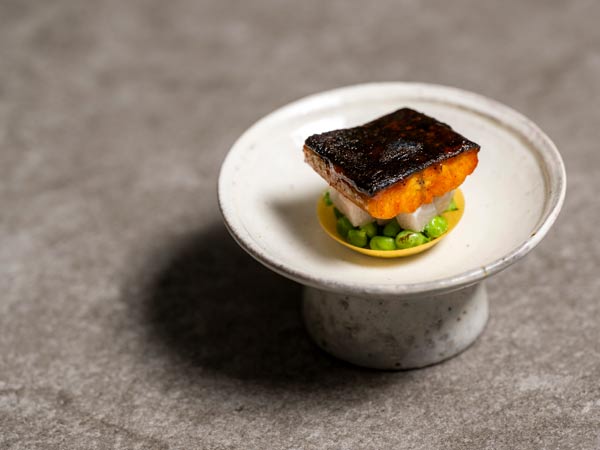
Yellowtail Freshwater Eel, a must-try dish in Atomix. (Image: Evan Sung)
I read a study a few years ago on how South Korea has used gastrodiplomacy to better their economy. This makes sense in the wider context of Hallyu (or, Korean Wave) that has seen the global popularisation of Korean culture through music, film and food. It’s a form of soft power that’s most obvious in New York City, where wider cultural trends are born almost daily.
Reportedly, there are over 500 Korean restaurants across the city hitting all price points. Casual charmers like Her Name is Han and tofu-based Cho Dang Gol are great for quick pop-ins, while institutions like Park’s Atoboy, known for the best fried chicken in New York, and pioneering fine diner Jungsik remain top-shelf experiences. I’ve even been to a Korean fine diner, Noksu, hidden in an otherwise unremarkable subway station. Cote, a luxurious take on KBBQ, is considered the best steakhouse in North America.
The reasons Korean food is so popular in an unforgiving, fickle city like New York are plentiful. But one is most obvious. Korean food lives and breathes on the art of fermentation. It’s this that brings a new depth of deliciousness to a city that’s already considered top tier for gourmands.
Fermentation tells the story of Korea’s strong seasonality. Once a survival technique for long winters, it’s now the foundation for the umami depth and textural complexity that give Korean ingredients their remarkable adaptability.
And it’s because of this that Korean ingredients have so much potential for chefs the world over, opening them up to complex tastes that can be used to find new flavour profiles in ongoing experiments.
And as the Culinary Institute of America taught me, what truly distinguishes the top brass in the culinary world is a precise understanding of how to build flavour. And sitting at that counter in New York, I realised the best meals don’t just feed you but teach you how to taste.
Enjoyed that? Discover the New York restaurants to have on your radar, according to Neil Perry.














LEAVE YOUR COMMENT